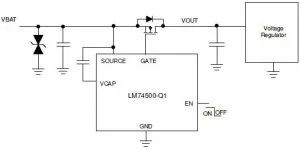Texas Instruments’ controller is suitable for applications such as body electronics and lighting
Texas Instruments’ LM74500-Q1 is an automotive AEC-Q100 qualified controller which operates in conjunction with an external N-channel MOSFET as a low-loss reverse polarity protection solution. The wide supply input range of 3.2 V to 65 V allows control of DC bus voltages such as 12 V, 24 V, and 48 V automotive battery systems. The 3.2 V input voltage support is particularly well-suited for severe cold crank requirements in automotive systems. The device can withstand and protect the loads from negative supply voltages down to -65 V.
The LM74500-Q1 does not have reverse current blocking and is suitable for input reverse polarity protection of loads that can potentially deliver energy back to the input supply such as automotive body control module motor loads. The LM74500-Q1 controller provides a charge pump gate drive for an external N-channel MOSFET. The high voltage rating simplifies the system designs for automotive ISO7637 protection. With the enable pin low, the controller is off and draws approximately 1 µA of current, offering low system current when put into sleep mode.
- AEC-Q100 qualified:
- Ambient temperature range Grade 1: -40°C to +125°C
- Device HBM ESD Classification Level 2
- Device CDM ESD Classification Level C4B
- Input range: 3.2 V to 65 V (3.9 V start-up)
- Input reverse voltage: -65 V
- Charge pump for an external N-Channel MOSFET
- Enable pin feature
- Shutdown current: 1 µA (EN=low)
- Typical operating quiescent current: 80 µA (EN=high)
- Meets automotive ISO7637 pulse 1 transient requirements with an additional TVS diode
- Package: 8-pin SOT-23 (2.90 mm x 1.60 mm)
Read more: LM74500-Q1 REVERSE POLARITY PROTECTION CONTROLLER

